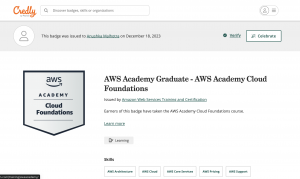AWS Academy Cloud Foundations Certificate

The AWS Academy Cloud Foundations Canvas course provided an in-depth understanding of the materials we learned in MIS 3406 – Cloud Architecture. We first learn about the advantages of the Cloud, especially in regards to its scalability and cost-effectiveness, along with an introduction to the AWS Cloud Adoption Framework. Through case studies, we also learn how to optimize cost through AWS’s various services and their relevance to business needs. Then the course introduces the functionality of various AWS services, such as EC2, Lambda, and other compute services, database services like DynamoDB, and AWS networking and content delivery services such as Cloudfront. We also learn about the concept of the AWS Global Infrastructure – that is, availability zones, regions, and edge locations that all serve to ensure fault-tolerance, high availability, elasticity and scalability. Through our labs, we learn about cloud security, working with features such as AWS IAM. We also learn to build out a VPC, launch a web server, and launch Amazon EC2 instances, which we learn how to do in detail in our MIS 3406 In-Class Activities as well. Another lesson found both in the MIS 3406 coursework and in the AWS Academy Cloud Foundations course is the introduction of storage services like Amazon S3. In later labs, we learn how to build a database server, and learn of the differences between database services like Amazon Aurora, DynamoDB, and Amazon Redshift. We then learn about troubleshooting through the AWS Trusted Advisor, which is a tool that can provide guidelines and recommendations after looking at a practitioner’s specific AWS environment and aligning the environment with AWS best practices. In the last module, we learn about the 3 types of Elastic Load Balanging: the Application Load Balancer, the Network Load Balancer, and the Classic Load Balancer. In our last lab, we create an Amazon Machine Image, a load balancer, and learn to auto-scale new instances. Finally, we learn about the benefits of Amazon CloudWatch for performance monitoring and troubleshooting. Through labs, case-studies, and in-depth videos, this course teaches many integral foundations for becoming a cloud practitioner.

